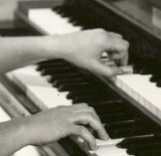
The opening of Mark Morris’s Drink to me only with thine eyes, choreographed to piano etudes by Virgil Thomson begins with a bizarre, meandering bitonal extravagance called Chromatic Double Harmonies (Portrait of Sylvia Marlowe), which the on-stage pianist plays for a long time without the interruption, so to speak, of any choreography. In one of the theatres where I was performing this with ENB, it looked like there would be a problem getting the piano on stage.
I talked the problem over with Mark:
‘And if we really can’t get the piano on stage, and I end up having to play in the pit, what about the opening?’ I asked.
‘Oh no, if that happens’, he said, laughing, ‘cut the opening. We don’t want to sit and listen to you solving musical problems in the pit!’.
It’s my favourite description of a piece of music. It describes and explains in three words exactly what the music does, better than the music itself can, which is why it has made me laugh ever since. It also encapsulates what I love about choreographers – they aren’t afraid of music in the way that musicians (including myself) are. They hear it, and know what it is, and strangely enough, for exponents of what is supposed to be a mute art form, they can be more eloquent and articulate about music in fewer words than a thousand music critics.
As friends know, I’m currently engaged in a module at the IoE on the Philosophy and Aesthetics of Music Education, and it’s precisely this kind of remark, with all its context (i.e. why should it be OK to watch someone solve musical problems, but not hear them? Answers in a ballet, please…) that invigorated my intellectual curiosity about such things in the first place.
And as it happens, I’ve solved another musical problem today. I had always wondered in what way this piece could be considered a portrait of Sylvia Marlowe, unless she were a lunatic that looked like a cubist painting in the flesh. But at last I found a photographic portrait of her at her dual manual harpsichord, and it all makes perfect sense.


I’m performing Drink to Me Only… for the first time—and attempting to solve the problem of Sylvia Marlowe…did you ever find a pattern to the meandering? Alternatively, did you experiment with adding harpsichord colors/style although not specified in the score?
How nice to meet a fellow DTMO performer! In answer to your question, I tried, but I don’t think I ever did – though it always seemed as if there must be a logic in there somewhere. A better analyst than me would probably find it, but I gave up. However, by the time I’d done it a few times, it seemed that it could not go any other way. To my shame I didn’t know who Sylvia Marlowe was until after I’d finished the tour (I was so concerned with learning notes I didn’t do much context – terrible admission!), so any harpsichord style/colour was accidental. But to bring out the singing top line on the first page I made the lower voice in the RH very brittle indeed, so maybe it
specified there? Have you reached the stage where double sevenths sound like normal harmony to you now, and sixths sound like dissonance?
Not quite–but the melody of the double sevenths is driving me nuts because I’ve heard something like it (folk songish) somewhere in the mists of time…(fog more likely!). Same for waltzing waters–similar to “Waltzing with Bears” so he is quoting something… an in joke nobody gets anymore!
I was like that about the music box – that sounds like a hymn, but I can’t think what it is. I guess I could musipedia it and see if it turns up.